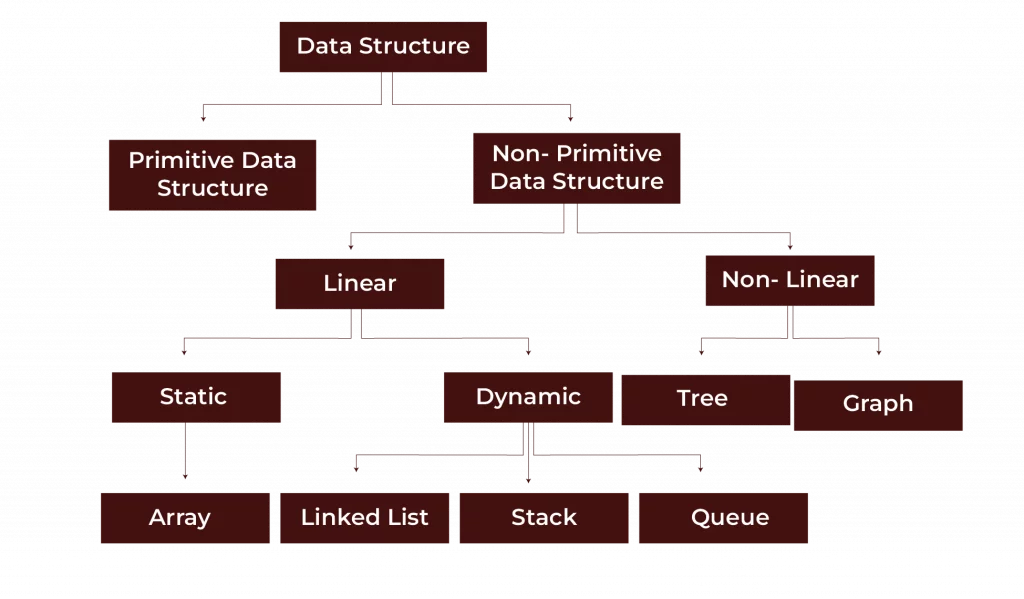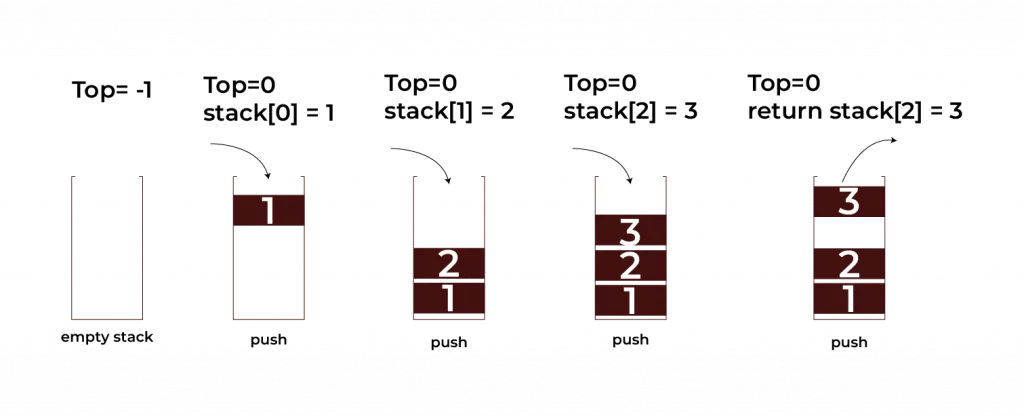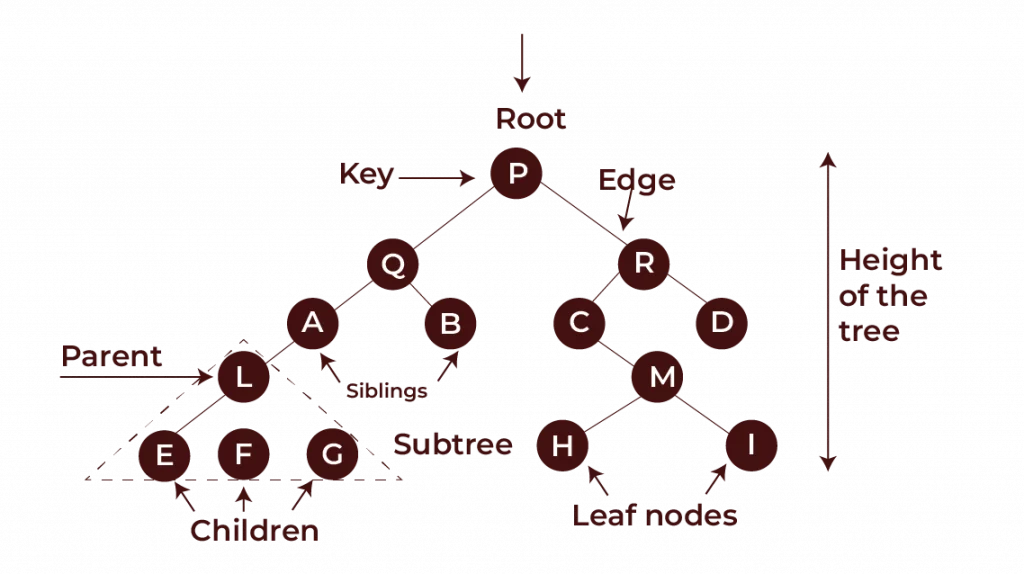Programming applications depend on data structures to function. Data structures enable efficient data management which provides easier access to store data while enabling efficient retrieval and processing capabilities.
Selecting appropriate data structures determines whether programs become fast, effective solutions or create excessive memory usage and lengthy execution time.
The data structure has two fundamental categories: primitive and non-primitive structures. Knowledge about these data structure varieties becomes vital for writing effective code, most particularly in big projects, database work, and system programming environments.
If you’re looking for a clear breakdown of these structures, their properties, and the difference between primitive and non-primitive data structures, this blog covers everything in detail with real-world examples.
What are Primitive and Non-Primitive Data Structures?

Primitive Data Structures
These are basic building blocks provided by programming languages. They store single values and take up fixed memory space. They are predefined, meaning we don’t need to define their structure before using them.
Examples:
- Integer (int)
- Float (float)
- Character (char)
- Boolean (bool)
Non-Primitive Data Structures
These are more complex and store multiple values, often of different types. They help in organising large datasets efficiently and enable advanced operations like sorting, searching, and traversal.
Examples:
- Arrays
- Linked Lists
- Stacks
- Queues
- Trees
- Graphs

POSTGRADUATE PROGRAM IN
Multi Cloud Architecture & DevOps
Master cloud architecture, DevOps practices, and automation to build scalable, resilient systems.
Highlighting Differences Between Primitive and Non-Primitive Data Structures
| Feature | Primitive Data Structure | Non-Primitive Data Structure |
| Definition | Stores a single value and is built into the language | Stores multiple values and is created using primitive types |
| Storage | Fixed memory allocation, stored in stack memory | Dynamic memory allocation, stored in heap memory |
| Operations | Supports basic arithmetic operations (+, -, *, /) | Supports sorting, searching, insertion, and deletion |
| Memory Usage | Fixed-size, low-memory | Dynamic size, higher memory |
| Mutability | Immutable in some languages | Mutable, allows modifications |
| Examples | int, float, char, bool | Arrays, Linked Lists, Stacks, Trees, Graphs |
Key Characteristics and Properties of Primitive Data Structures
Primitive data structures are straightforward. They store a single value at a time and require less memory.
Key Properties
- Predefined in Programming Languages – We don’t need to define them explicitly.
- Stored in Stack Memory – This makes them faster to access.
- Immutable in Nature – Once assigned, their values cannot be changed (in languages like Java and Python).
- Cannot Store NULL Values – They always hold a value.
Example Usage in C and Java
C Example
int age = 25;
float price = 99.99;
char grade = ‘A’;
Here, int stores whole numbers, float stores decimal values, and char holds a single character.
Java Example
int score = 90;
boolean isPassed = true;
char initial = ‘R’;
These are directly stored in stack memory, making them efficient in handling small values.
Common Types of Primitive Data Structures with Examples in Different Programming Languages
Different programming languages support the same primitive types, but their implementation varies slightly.

| Primitive Type | Description | C/C++ Example | Java Example |
| Integer (int) | Stores whole numbers | int marks = 85; | int age = 30; |
| Float (float) | Stores decimal numbers | float price = 9.99; | float salary = 45000.5f; |
| Double (double) | Stores high-precision decimal numbers | double pi = 3.14159; | double rate = 7.25; |
| Character (char) | Stores single characters | char grade = ‘A’; | char symbol = ‘₹’; |
| Boolean (bool) | Stores true or false values | bool isValid = true; | boolean isLoggedIn = false; |
Key Differences Between Float and Double
- float stores single-precision values (less accurate but memory-efficient).
- double stores double-precision values (more accurate but consumes more memory).

82.9%
of professionals don't believe their degree can help them get ahead at work.
Key Characteristics and Properties of Non-Primitive Data Structures
Non-primitive data structures are designed to store multiple values in an organised manner. Unlike primitive types, which hold a single value, non-primitive structures help manage large datasets, relationships between elements, and complex operations like sorting and searching.
Key Properties
Can store multiple values – Unlike primitive types, which store only one value at a time, non-primitive data structures hold collections of data.
Require dynamic memory allocation – These structures are stored in heap memory, allowing flexible memory usage.
Support advanced operations – Non-primitive types allow sorting, searching, traversal, insertion, and deletion.
Can store different data types – Unlike primitive types, which hold only one type of data, non-primitive structures can mix multiple data types within the same structure.
Implemented using primitive types – Arrays, linked lists, and other complex structures are built using primitive data types.
Common Types of Non-Primitive Data Structures with Examples
Different programming languages provide various non-primitive data structures, but the most widely used ones include arrays, linked lists, stacks, queues, trees, and graphs.
Arrays
An array is a collection of similar data types stored in contiguous memory locations. It allows fast access to elements using an index, making it efficient for searching and sorting algorithms.

Linked Lists
A linked list consists of nodes, where each node contains data and a reference to the next node. It provides efficient insertion and deletion but takes more memory due to pointers.
Stacks
A stack follows the Last In, First Out (LIFO) principle. The last element inserted is the first one removed.

Operations:
- Push – Insert an element.
- Pop – Remove an element.
- Peek – Get the top element.
Queues
A queue follows the First In, First Out (FIFO) principle, where the first element added is the first to be removed.

Operations:
- Enqueue – Insert an element at the end.
- Dequeue – Remove an element from the front.
Trees
A tree is a hierarchical data structure where each node has a parent-child relationship. The root node is the starting point, and nodes branch out.

Common tree types:
- Binary Search Tree (BST) – Each node has at most two children, and the left child is always smaller than the parent.
- AVL Tree – A self-balancing BST ensuring faster lookup times.
Graphs
A graph consists of nodes (vertices) and edges (connections between them). Used in social networks, navigation systems, and recommendation engines.
Common representations:
- Adjacency Matrix
- Adjacency List
Operations Supported by Primitive and Non-Primitive Data Structures
Primitive Data Structures – Basic Operations
- Arithmetic operations: +, -, *, /
- Comparison operations: <, >, ==, !=
Non-Primitive Data Structures – Advanced Operations
- Insertion and Deletion – Adding/removing elements in arrays, linked lists, stacks, queues, trees, and graphs.
- Traversal – Accessing elements in sequential or hierarchical order.
- Sorting and Searching – Algorithms like binary search, merge sort, and quicksort.
Memory Allocation Difference Between Primitive and Non-Primitive Data Structure: Stack vs Heap Storage
Understanding how primitive and non-primitive data structures are stored in memory is crucial for writing efficient and optimised code. The key difference lies in whether a variable is stored in stack memory or heap memory.
Stack Memory (Used for Primitive Data Structures)
Primitive data structures are stored in stack memory, which makes them faster to access.
Stack memory is fast, automatically managed, and follows the Last In, First Out (LIFO) principle. It is used to store primitive types and local variables within functions.
- Directly stores values without extra references.
- Faster access since memory is allocated and deallocated automatically.
- Limited in size, making it unsuitable for storing large data structures.
- No need for garbage collection like heap memory.
Heap Memory (Used for Non-Primitive Data Structures)
Non-primitive types are stored in heap memory. Heap memory is larger, dynamically allocated, and managed by garbage collection (in languages like Java and Python). It is used for storing objects, arrays, and other complex data structures.
- Allocates memory at runtime, making it suitable for large or flexible data structures.
- Slower access compared to stack because of additional memory management overhead.
- Requires manual memory management in languages like C (using malloc() and free()).
Key Differences Between Stack and Heap Memory
| Feature | Stack Memory (Primitive Types) | Heap Memory (Non-Primitive Types) |
| Speed | Faster | Slower |
| Memory Type | Static (Fixed size) | Dynamic (Can grow/shrink) |
| Data Stored | Primitive values (int, char) | Objects, arrays, linked lists |
| Access Method | Direct | Indirect (via references) |
| Lifetime | Automatically managed | Requires garbage collection (Java) or manual deallocation (C) |
Why Does This Matter?
- Choosing stack storage is best for simple, temporary variables where speed is important.
- Choosing heap storage is best for dynamic data structures where flexibility is required.
- Poor heap memory management can lead to memory leaks, slowing down applications.
Advantages and Disadvantages of Primitive and Non-Primitive Data Structures
Advantages of Primitive Data Structures
- Simple and easy to use – Requires no additional setup.
- Efficient memory usage – Fixed memory size prevents excessive allocation.
- Fast access – Stored in stack memory, ensuring quick execution.
- Minimal Memory Consumption – Fixed-size allocation ensures low memory usage.
Disadvantages of Primitive Data Structures
- Cannot store multiple values – Only holds a single data unit at a time.
- Limited operations – Cannot support sorting, searching, or complex relationships.
- Not Suitable for Large Data Handling – Primitive types lack efficient ways to store and manage structured data.
Advantages of Non-Primitive Data Structures
- Can store multiple values – Handles large datasets effectively.
- Supports advanced operations – Enables efficient sorting, searching, and traversal.
- Scalable – Adapts dynamically to varying data sizes.
- Efficient Data Management – Allows relationships between data elements, making it useful for databases, graphs, and hierarchical data.
Disadvantages of Non-Primitive Data Structures
- Consumes more memory – Requires dynamic allocation in heap memory.
- Slower access speed – Needs extra memory management.
- Complex Implementation – Requires additional logic to manage pointers, memory allocation, and garbage collection.
Which Programming Languages Handle Primitive and Non-primitive Types Differently?
Different languages classify and store data structures uniquely.
- Java – Distinguishes primitive types (stack) and non-primitive types (heap, objects, arrays). Strings are non-primitive.
- Python – Treats everything as an object, even primitive types like int, float, and bool.
- C – Uses both stack (primitives) and heap (dynamic memory allocation). Strings are character arrays, not objects.
- JavaScript – Uses primitives for numbers, strings, and booleans but stores objects in heap memory.
Understanding these differences helps in choosing the right data structure for memory optimisation and performance.
Situations Where Primitive Data Structures Are More Suitable Than Non-Primitive
Choosing the right data structure depends on the complexity of the data, memory constraints, and required operations. There are situations where primitive data structures are the best option.
When to Use Primitive Data Structures:
Handling Simple Variables – If a program needs to store individual values like age, score, or temperature, a primitive type like int or float is more efficient.
Fast Execution Without Overhead – Primitive types require less memory and direct storage in the stack, making them ideal for time-sensitive computations.
Temporary Data Storage – When a program needs short-lived values, such as loop counters, flags, or simple calculations, primitive types work best.
Optimised Memory Usage – Since primitive types do not require extra memory for references or pointers, they help optimise space in memory-limited environments.
Mathematical Computations – Arithmetic operations like addition, subtraction, multiplication, and division are faster when using primitive data types rather than objects.
How Primitive and Non-Primitive Data Structures Are Used in Real-World Applications
Both primitive and non-primitive data structures play a key role in software development. Their choice depends on the complexity of data storage and retrieval.
Primitive Data Structures in Real-World Applications
- Embedded Systems – Small-scale microcontrollers use primitive data types for sensor readings, counters, and status flags.
- Banking Applications – Account balances, transaction IDs, and interest rates are stored using float, double, and integer types.
- Scientific Calculations – Physics and mathematics-based applications use primitive types for quick computations.
- System-Level Programming – Operating systems and hardware-level programming rely on primitive data types for fast processing.
Non-Primitive Data Structures in Real-World Applications
- Databases – Arrays and linked lists manage large datasets efficiently in MySQL, PostgreSQL, and MongoDB.
- Social Media Platforms – Graphs represent connections between users, as seen in Facebook’s friend network.
- Search Engines – Trees like binary search trees (BSTs) help store indexed search data.
- E-Commerce Websites – Queues handle customer orders, ensuring first-come, first-served processing.
- Navigation Systems – Graphs help in finding the shortest paths in Google Maps and GPS tracking applications.
Example: Temperature Logger Using Primitive Data Structures
A temperature monitoring system in a manufacturing plant records hourly temperatures using an array of float values. Since each value represents a single reading, using a primitive type is the most efficient way to store and process the data.
C Example: Storing Temperature Readings Using Float
#include <stdio.h>
int main() {
float temperatures[24] = {27.5, 28.2, 26.8, 25.9}; // Temperature readings
printf("Temperature at 2 AM: %.2f°C\n", temperatures[2]);
return 0;
}
This approach ensures fast storage and retrieval of simple data.
Example: Bookstore Inventory Using Non-Primitive Data Structures
A bookstore maintains a list of books with details like title, author, and price. Using an array or linked list helps store and retrieve book details efficiently.
Java Example: Managing Book Inventory Using an ArrayList
import java.util.ArrayList;
class Book {
String title;
double price;
Book(String title, double price) {
this.title = title;
this.price = price;
}
}
class Inventory {
ArrayList<Book> books = new ArrayList<>();
void addBook(String title, double price) {
books.add(new Book(title, price));
}
void displayBooks() {
for (Book book : books) {
System.out.println("Book: " + book.title + " - Price: " + book.price);
}
}
}
public class Main { // Ensure the filename is Main.java
public static void main(String[] args) {
Inventory inventory = new Inventory();
inventory.addBook("Data Structures", 599.50);
inventory.addBook("Algorithms", 749.00);
inventory.displayBooks();
}
}
Using a dynamic list allows flexible inventory management, unlike primitive arrays with fixed sizes.
Conclusion
Primitive and non-primitive data structures play a crucial role in programming. Primitive data structures handle single values efficiently, ensuring fast execution with minimal memory usage. Non-primitive data structures store collections of data, supporting advanced operations like sorting, searching, and traversal. Stack memory optimises performance for primitive types, while heap memory enables dynamic allocation for complex structures.
The difference between primitive and non-primitive data structures determines how efficiently data is stored, processed, and retrieved. Primitive types work best for simple computations, while non-primitive types organise large datasets in databases, search engines, and navigation systems. Choosing the right structure depends on data complexity, performance needs, and application requirements. Understanding this distinction leads to optimised coding and better resource management.
For those looking to advance their programming skills and gain industry expertise, the Certificate Program in Application Development by Hero Vired offers hands-on training in data structures, algorithms, and real-world software development.
Why are primitive data structures stored in stack memory while non-primitive ones are in heap memory?
Can a primitive data structure hold NULL values?
Is a string always a non-primitive data type?
What are the biggest performance differences between primitive and non-primitive structures?
Which data structure should I use when working with large datasets?
Updated on February 22, 2025
